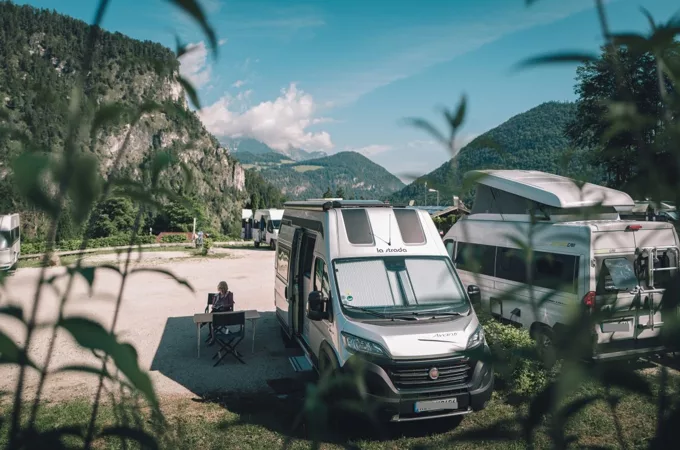Buying a motorhome – important tips
Camping has been a megatrend in recent years.
But one question is a constant source of debate: Caravan or motorhome?
The advantages of camping trailers include the lower purchase costs and the option of using the towing vehicle at the destination for excursions.
Motorized motorhomes, on the other hand, score points for example with better manoeuvrability and greater flexibility for overnight stays on the road.
In the German statistics, the motorhome is clearly in the lead: almost 840,000 motorhomes are currently registered in Germany, compared to 760,000 caravans.
Whether it’s a minibus, panel van, semi-integrated or integrated vehicle: What do you need to know about motorhomes?
GTÜ Gesellschaft für Technische Überwachung mbH provides an overview.
The whole world of these vehicles is open to anyone in Germany who has an old Class 3 driving license.
This license was issued until December 31, 1998.
You are allowed to drive all vehicles up to a total weight of 7.5 tons.
That’s quite a lot.
But there are also motorhomes based on trucks or buses that exceed this.
For these, you not only have to dig deep into your pockets when buying them, but also acquire a truck driver’s license.
Anyone who has obtained a German class B driving license after January 1, 1999, may drive vehicles with a maximum permissible weight of 3.5 tons.
Good to know: The driver’s license can be extended.
Class C1 entitles you to drive vehicles up to 7.5 tons.
The driving license can be renewed every five years after a health and eye examination.
Many a camping novice is quick to buy a vehicle.
But it’s not a bad idea to rent the vehicle of your choice or a similar model first.
This allows you to try out living on four wheels and also driving.
Some people will adjust their choice of vehicle after this real-life experience and perhaps choose a larger motorhome – for example, if the space available in the panel van does not quite match the expected dance hall.
Or, conversely, a smaller vehicle because it is simply more maneuverable.
It is also helpful to visit large camping fairs to get information.
A fully equipped minibus still drives most like a car and is also maneuverable in the city or when looking for a parking space.
The larger the vehicle, the more the characteristics change.
For example, a large motorhome generally accelerates much more slowly than a car, and the braking distance can be significantly longer.
Relaxed and anticipatory driving is important – which motorhome professionals already consider to be part of deceleration and a plus point for a vacation on four wheels.
With a full-size motorhome, you’re not exactly nimble on the road.
That’s why you always have to keep an eye on the sheer size of the vehicle to avoid getting stuck on the side in tight bends or in low passages.
When reversing out, the usually generous “blind spot” must be observed.
When reversing, a second guide is essential and a reversing camera is also helpful.
Driver safety training is always a good idea.
This teaches you how to better control the vehicle in tricky situations such as evasive maneuvers or emergency braking.
Special navigation systems that take the dimensions of the vehicle into account when planning the route are also helpful: very narrow roads or low passages, for example, are then ignored.
Of course, this does not absolve you from paying attention to the relevant traffic and information signs, as not all the important points are accurately shown on the digital road maps.
When loading vacation equipment, the permissible total mass must be observed.
If the motorhome has an unladen weight of 2,900 kilograms with all fittings and additional equipment and may weigh a maximum of 3,500 kilograms, 600 kilograms may be loaded.
As a motorhome cannot drive without a driver, the driver is already included in the unladen weight with 75 kilograms.
Each additional person counts as additional weight.
So if, for example, three people, perhaps a dog and the family’s full luggage are added, 600 kilograms of payload is no longer quite so generous.
If the permissible total weight is exceeded, fines will be imposed, which in some countries can run into four figures.
Each item should be weighed individually before loading: Ideally, you should take the fully packed motorhome to a weighbridge.
These are often available nearby, for example from building material dealers or waste disposal companies.
Which traffic rules apply?
Here are a few examples: Up to a gross vehicle weight of 3.5 tons, the same speed limits apply as for cars.
Up to 7.5 tons, the speed limit is 80 km/h outside built-up areas and on freeways and 100 km/h on freeways.
For trucks over 7.5 tons, speed limits apply: 60 km/h outside built-up areas and 80 km/h on dual carriageways and freeways.
Some signs also apply to motorhomes: if there is a prohibition on driving through, a prohibition on overtaking or a distance requirement for trucks, this also applies to motorhomes over 3.5 tons.
Passage bans for trucks with a certain length specified on the traffic sign or for vehicles with a higher axle load than specified on the traffic sign are rarer: These naturally also apply to motorhomes with these characteristics.
It goes without saying that motorhomes in Germany are also subject to regular general inspections (HU) in accordance with Section 29 of the German Road Traffic Licensing Regulations (StVZO), including exhaust emission tests.
The GTÜ test centers are happy to welcome camping enthusiasts – and it is not unusual for a lively conversation to develop about the last vacation trip with the vehicle.
A motorhome up to 3.5 tons is treated like a passenger car: If it is new, the first general inspection is due after three years.
After that, it must be inspected every two years.
For motorhomes from 3.5 to 7.5 tons, the first general inspection is due after two years at the latest.
After that, the vehicle must also be presented for an inspection every two years.
From the sixth year onwards, the inspection is due annually.
Motorhomes with a gross vehicle weight of more than 7.5 tons must always undergo a general inspection once a year.
Many motorhomes have gas-powered appliances on board, including a stove or heater.
The gas system must be checked regularly for leaks.
The gas test does not have to be carried out with the main inspection, but is often the easiest.
GTÜ test centers are also equipped for this.
GTÜ’s caravanning guide offers comprehensive knowledge about motorhomes and caravans as well as many exciting topics.
Its motto: become a camping pro in a hundred pages.
The booklet is available from all participating GTÜ partners.
Curious?
There is also a digital preview: GTÜ – Caravan Guide
Note: The laws, regulations and ordinances mentioned in this article relate to the Federal Republic of Germany.
Other legal requirements may apply in other countries.





